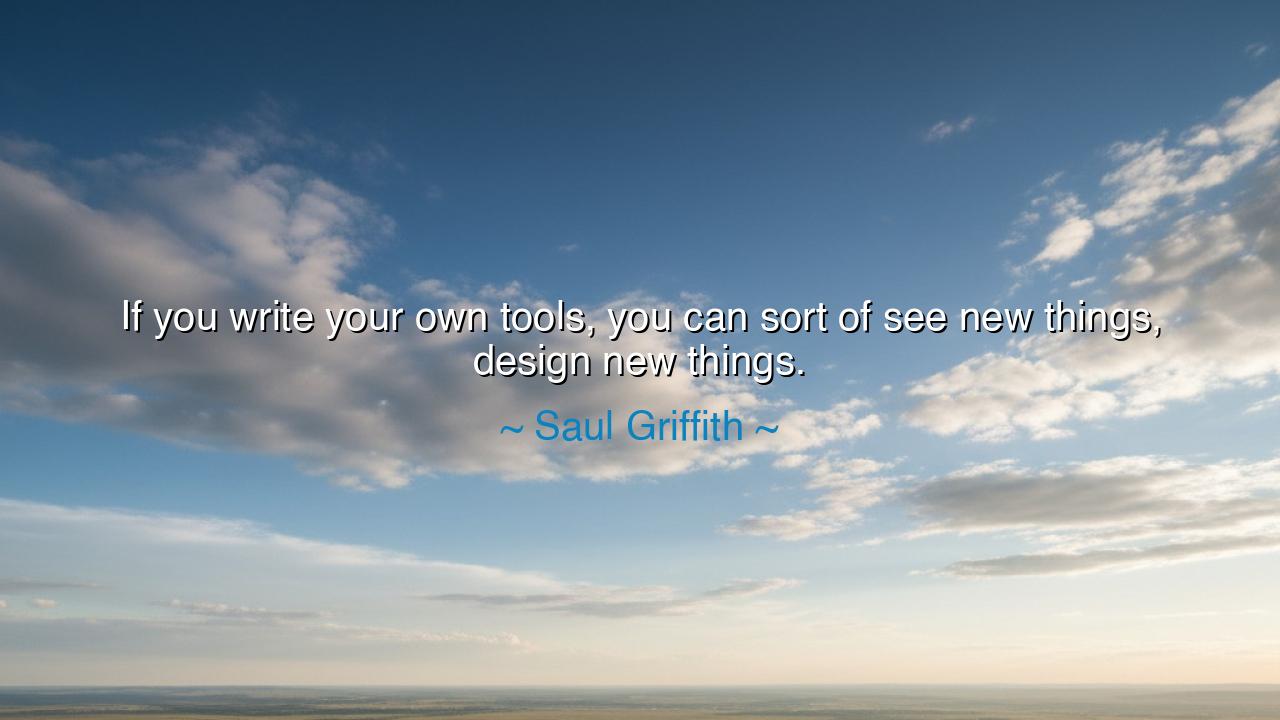
If you write your own tools, you can sort of see new things






In the visionary words of Saul Griffith, inventor and thinker of the modern age, there resounds a timeless truth that could have been spoken in any era of human endeavor: “If you write your own tools, you can sort of see new things, design new things.” Though born from the language of invention, these words echo far beyond machines and code — they speak to the essence of creation itself. Griffith’s wisdom reminds us that true vision does not come from merely using what others have built, but from daring to create the means of creation. For the toolmaker is not merely a craftsman — he is the architect of possibility, the one who reshapes the very boundaries of what can be imagined.
From the dawn of civilization, this truth has guided humanity’s rise. When our ancestors chipped flint into blades, they did not simply make a tool — they opened the door to a new way of seeing the world. The spear allowed the hunter to extend his reach, the wheel allowed the traveler to conquer distance, and the brush allowed the artist to reveal his soul upon stone and parchment. Each tool was not just an instrument of use, but a lens of discovery. As Griffith tells us, when one fashions their own instrument, they learn to perceive what others cannot. For the hand that builds learns to question, and the mind that questions begins to see differently.
Consider the genius of Leonardo da Vinci, who, centuries before Griffith, embodied this philosophy in flesh and spirit. Leonardo did not rely on the tools of others; he forged his own — sketching inventions, machines, and instruments that often existed only in his mind. His brushes, gears, and flying contraptions were not mere curiosities, but the pathways to new realms of understanding. In building his own tools, he learned to see nature as a grand mechanism, a harmony of motion and proportion. Through his tools, he did not only create art — he created the very way we look at art and science. The tools were his teachers, and through them, his vision expanded beyond his age.
Griffith, too, speaks from this lineage of makers — those who understand that invention begins not with materials, but with imagination. In the modern world, we are surrounded by tools built by others — algorithms, programs, devices — and while they grant us ease, they also build invisible walls around our creativity. To “write your own tools,” in Griffith’s sense, is an act of rebellion against these invisible limits. It is the choice to shape your own instruments of thought and action, rather than remain confined by the visions of others. In this, there is a kind of spiritual craftsmanship — for the maker not only creates tools, but creates himself through them.
This principle can be seen in the story of Steve Wozniak, co-founder of Apple, who in his youth built his own computers from spare parts, long before such things could be purchased. He did not merely assemble — he understood, line by line, wire by wire, how a machine could think. In building his tools, he unlocked the ability to design the future. Like a smith forging his own hammer before shaping the sword, Wozniak’s act of toolmaking gave him mastery not just over the product, but over the process — and in that mastery, he glimpsed possibilities unseen by others. Thus, the lineage of Griffith’s words runs from the first inventor of fire to the engineers of light and code: those who build the means to build are the ones who truly advance the world.
But this truth does not belong only to engineers or artists — it belongs to all who seek mastery in life. To write your own tools is to take ownership of your craft, whatever it may be. The teacher who invents new ways to inspire her students, the farmer who shapes his own plow from what the land provides, the writer who crafts new forms of expression — each is rewriting the toolset of their world. And in doing so, they begin to see new things: solutions where others see obstacles, beauty where others see routine, meaning where others see mere labor. The act of creation begets new perception.
Let this be the lesson passed down to those who will build the worlds to come: Do not merely use the tools you are given — question them, reshape them, outgrow them. Build your own. For when you create your own means of work, you awaken new ways of seeing and thinking. The one who relies only on inherited tools remains a user of the past; the one who fashions his own becomes a creator of the future. Begin small — a new method, a new instrument, a new way of thinking — and soon you will find that your world itself has changed shape beneath your hands.
And so, my children, remember: the universe itself was written by a Maker who forged His own laws and elements. To follow in that path is not arrogance, but homage. Whether you work in wood, in metal, in words, or in code, be not merely a user of tools — be a writer of them. For in writing your tools, you write the story of discovery, and in doing so, you may come to see the invisible, and design not only new things — but a new way of being.






AAdministratorAdministrator
Welcome, honored guests. Please leave a comment, we will respond soon